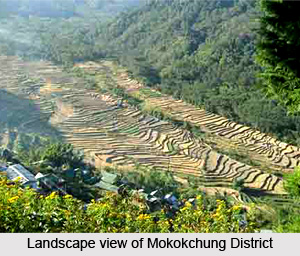 Geography of Mokokchung District is the exploration of the several mountainous regions and the flowing rivers and the green vegetation all around. Mokokchung District is bounded by the state of Assam to its north, Tuensang to its east, Zunheboto to its south and Wokha and Assam to its west, and lies between 93.53 and 94.53 Degrees Longitude and 25.56 Degrees Latitude.
Geography of Mokokchung District is the exploration of the several mountainous regions and the flowing rivers and the green vegetation all around. Mokokchung District is bounded by the state of Assam to its north, Tuensang to its east, Zunheboto to its south and Wokha and Assam to its west, and lies between 93.53 and 94.53 Degrees Longitude and 25.56 Degrees Latitude.
There are several Ranges that run more or less parallel to each other in North-east or South-west direction. Between the Ranges, there are glens and gorges through which flow the hill streams. There are only two small valleys namely Changki and Tuli, and both of them are on the western side of the district adjoining the plains of the Sibsagar district of Assam. The entire District of Mokokchung is conveniently sub-divided into Ranges.
Tzurangkong Range is actually pimples of hillocks thrown at random adjoining the plains of Assam mostly along the valley of Dissai River and Jhanzi Rivers just before they flow into the plains of Assam. These hillocks are densely covered with bamboos and the climate of the entire range is warm.
Japukong Range is the outermost Range stretching from North-east to South-west lying to the interior south of Tzurangkong Range. Changkikong Range is a parallel Range east of Japukong Range. Changki village was said to be founded by a man named Changki, and so the Range too was named after him as Changkikong. Asetkong Range is a Central Range running from east to west but compared to the other ranges, it is the shortest one. This range lies between Melak and Menung rivers, and therefore, it resembles an island. Hence the name thrives to be Asetkong. Langpangkong Range is the easternmost range skirting along the course of Dikhu River. The river forms a natural boundary line of Mokokchung with Tuensang and Mon districts. This range is spread like a bed and so the name has been aptly given to this range. Ongpangkong Range is the southernmost range forming an irregular boundary of the Ao area with that of the Lothas and Semas to the south and with the Sangtams to the east. It is called Ongpangkong as the land is higher and cooler than the other ranges and the word has its etymological roots in the term higher.



















